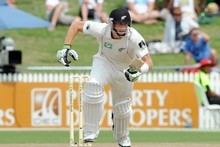
Martin Guptill.
The pyjamas and premeditated shots of the HRV Cup will be put away as New Zealand don the creams to combat Zimbabwe in a one-off test.
Playing a test after the domestic Twenty20 competition generates a number of questions. Can batsmen adapt to the longer form of the game where sessions rather than strike rates become more valuable? Can bowlers adjust to a slip cordon rather than fields of containment?
Last season's evidence saw New Zealand struggle against Pakistan in those circumstances. Most top players had come off an arduous tour of India, losing the three test series 1-0 and one-dayers 5-0.
They then played a handful of HRV Cup matches and three T20 games against Pakistan before the two tests. That was followed by a 10-wicket trouncing inside three days at Hamilton, capitulating for 110 in the second innings.
If a traditional batsman's paradise is prepared at McLean Park, a repeat embarrassment is likely to be avoided, but making the transition from local T20 cricket to tests presents mental and technical barriers.
Craig McMillan played all three formats for New Zealand (test batting average 38.46, one-day average 28.18, T20 average 31.16). He says the transition is the greatest challenge for modern day batsmen.
"It generally takes at least one first-class game to come to grips with the longer form again. You're going from trying to score at least 12 runs an over by hitting every ball to the boundary to battling at the crease for sessions where you can actually leave the ball. You've got to switch out of T20 auto-pilot because, as a batsman, if you make one mistake - it's innings over. It is so much longer sitting in a dressing room during a test than a T20.
"New Zealand also has to be wary with talent such as Martin Guptill, Ross Taylor and Brendon McCullum who like to get bat on ball. Going back to leaving the ball is difficult, especially when you get some width to work with."
McMillan says it's hard to get out of the habit of pre-meditated shots.
"Take Guptill. He's constantly sitting back in the crease waiting for a ball he can launch over the legside. You've got to get rid of that. It illustrates why Twenty20 is a proactive batting game, whereas test matches are more reactive, waiting to see what the bowler will do."
Shane Bond, a New Zealand bowling great across all forms, says the step up to tests also takes a toll on bowlers.
"The biggest difference is time spent on your feet. Anything more than 20 overs seems to take forever. In T20, you spend more time guessing what a batsman is trying to do because they are so short of time. In tests, you can settle into a better routine and bowling plan. It is easier to go back to tests in that respect.
"Another aspect is that your T20 line and length varies massively whether it's bowling slow bouncers, yorkers, wide of the crease or close to the stumps. It's the licorice allsorts of bowling. It feels weird returning to tests with three slips and a gully; you feel void of protection on the boundaries."
New Zealand has achieved a successful transition from T20 to tests in the past. After the 2005-06 T20 competition, New Zealand beat the West Indies by 27 runs in the first test and won the three-match series 2-0, their last series win against a top-eight nation at home. There were no tests after the 2006-07 T20 because of the World Cup but in 2007-08, New Zealand beat England by 189 runs at Hamilton in the first test before losing the series 2-1.
In 2008-09, New Zealand opened the test series with a 10-wicket loss to India (the Black Caps were unavailable for much of the local T20), while in 2009-10, they beat Bangladesh but then lost to Australia by 10 wickets.
The difference with past years is there has always been an international T20 or 50-over series leading into the tests. The 45-day gap between tests for the New Zealand players is about to face a rigorous examination.
Source:http://www.nzherald.co.nz/sport/news/article.cfm?c_id=4&objectid=10780220
No comments:
Post a Comment